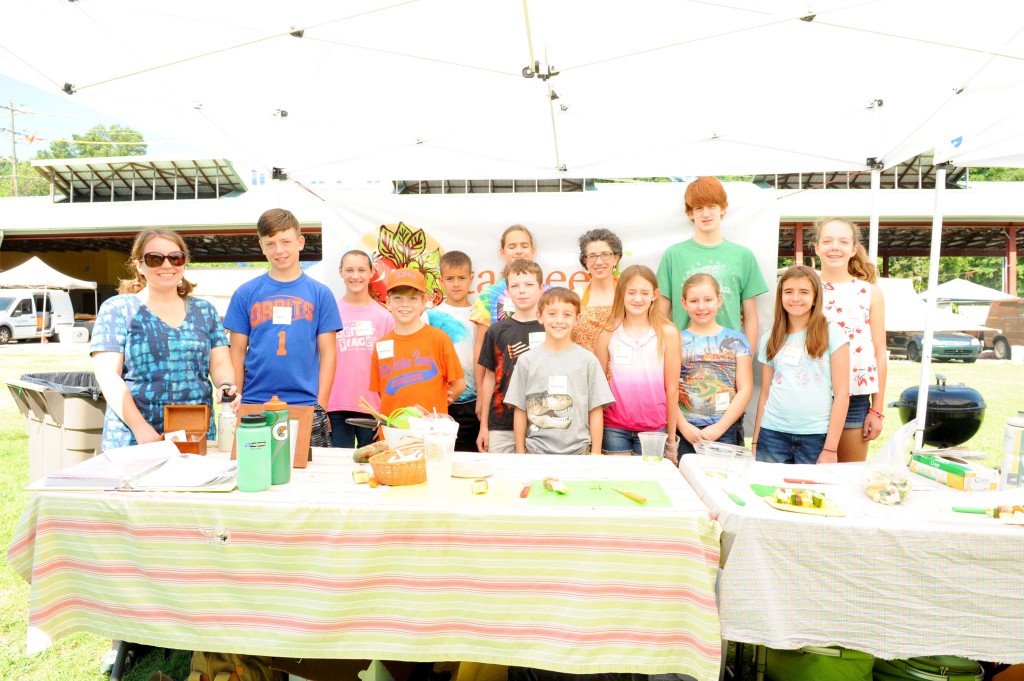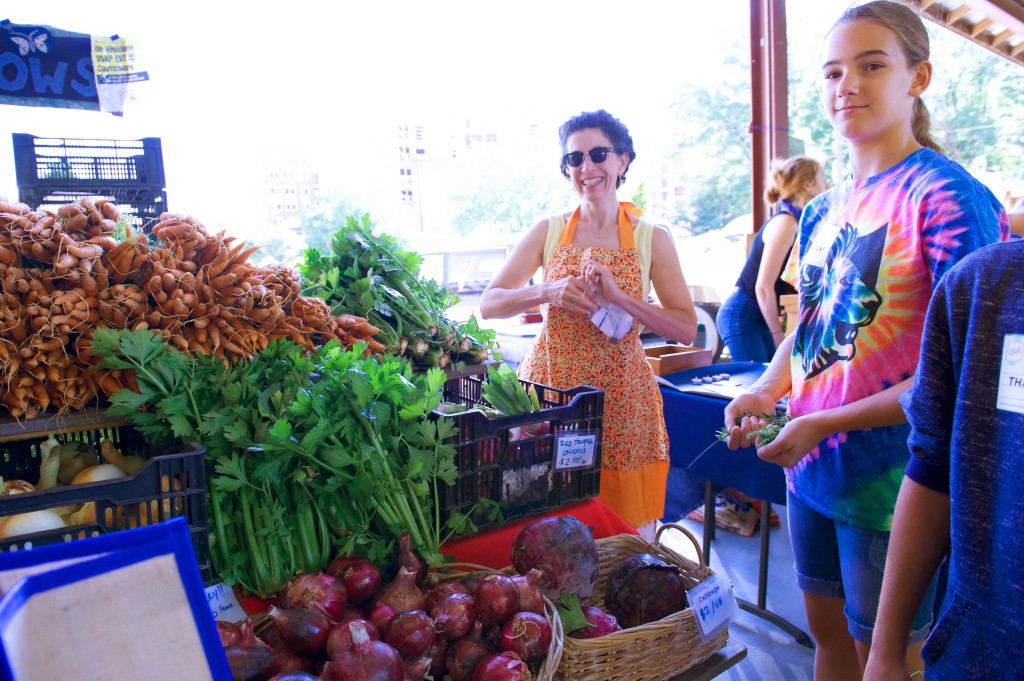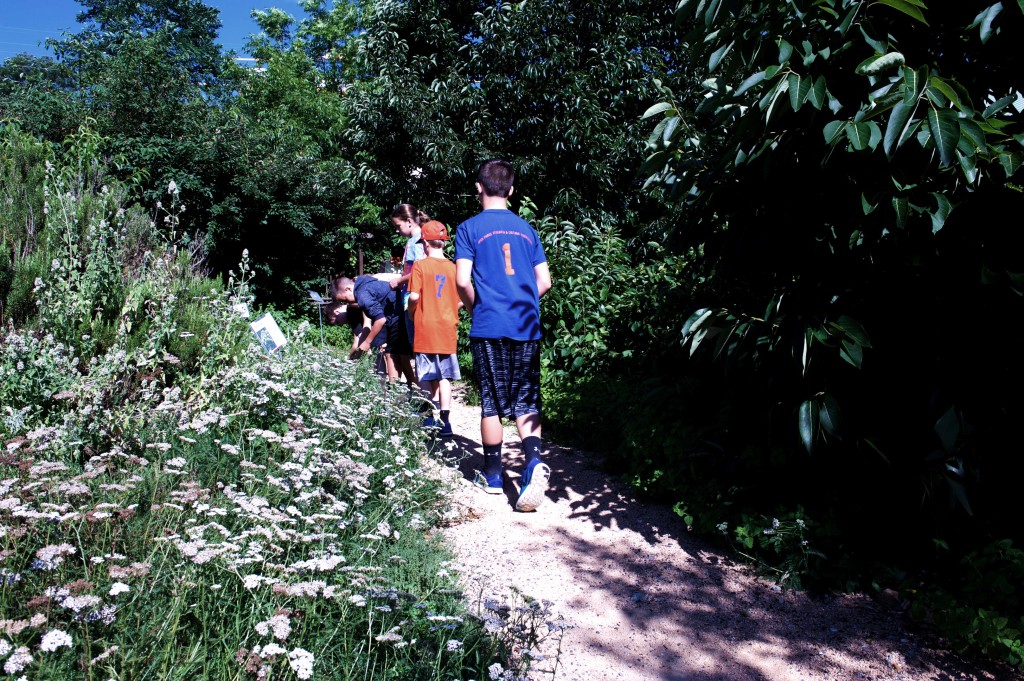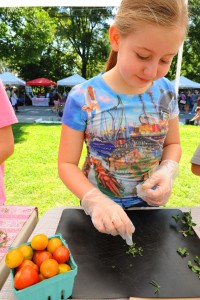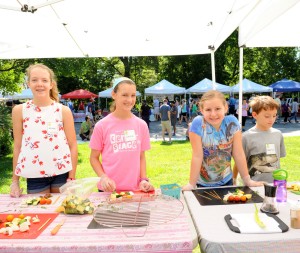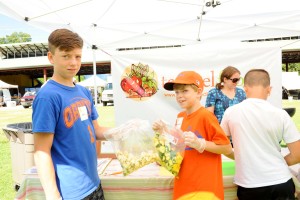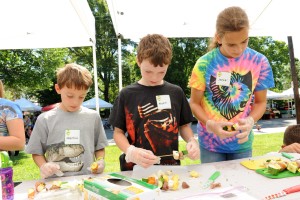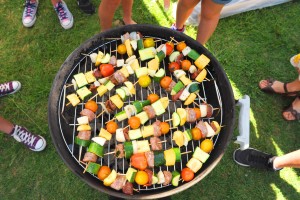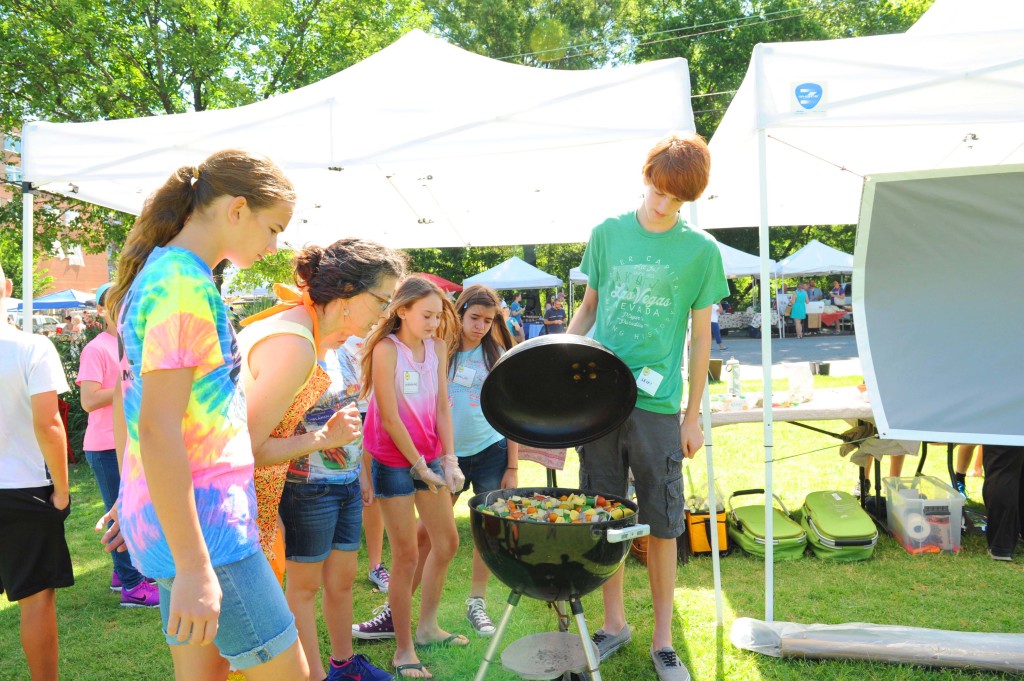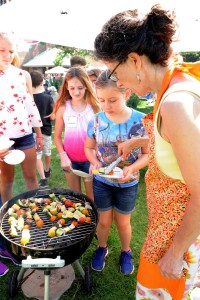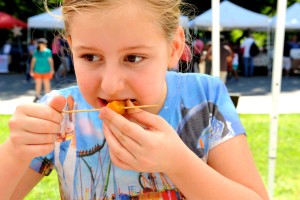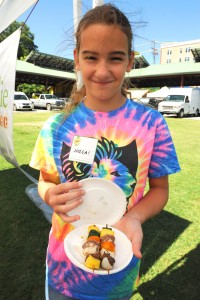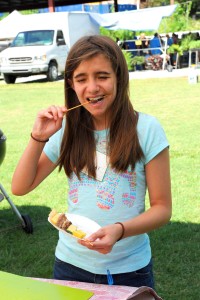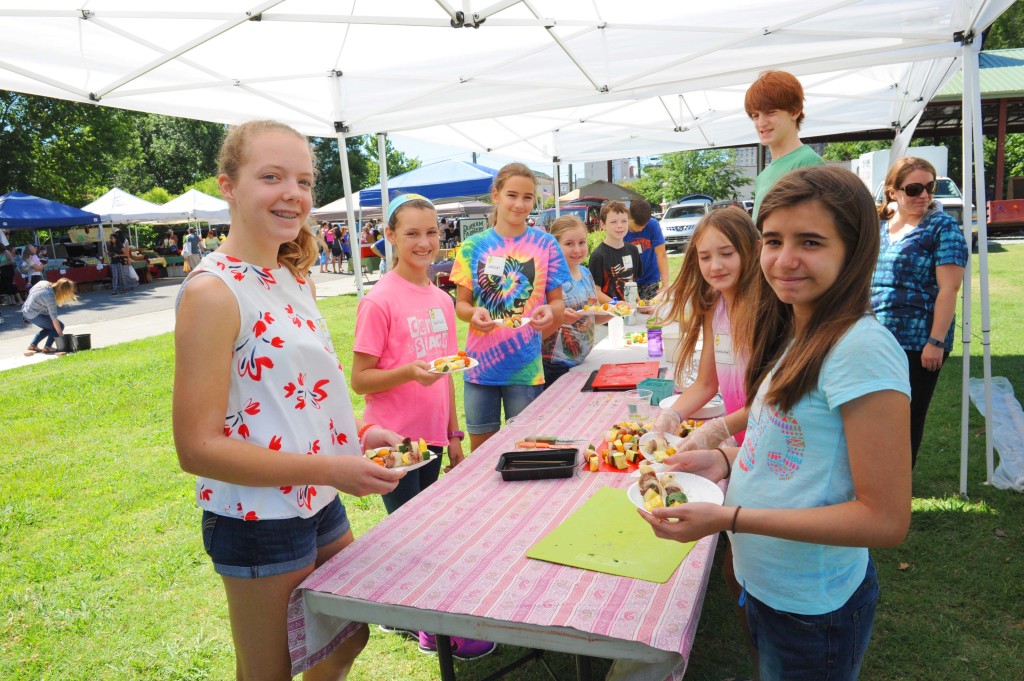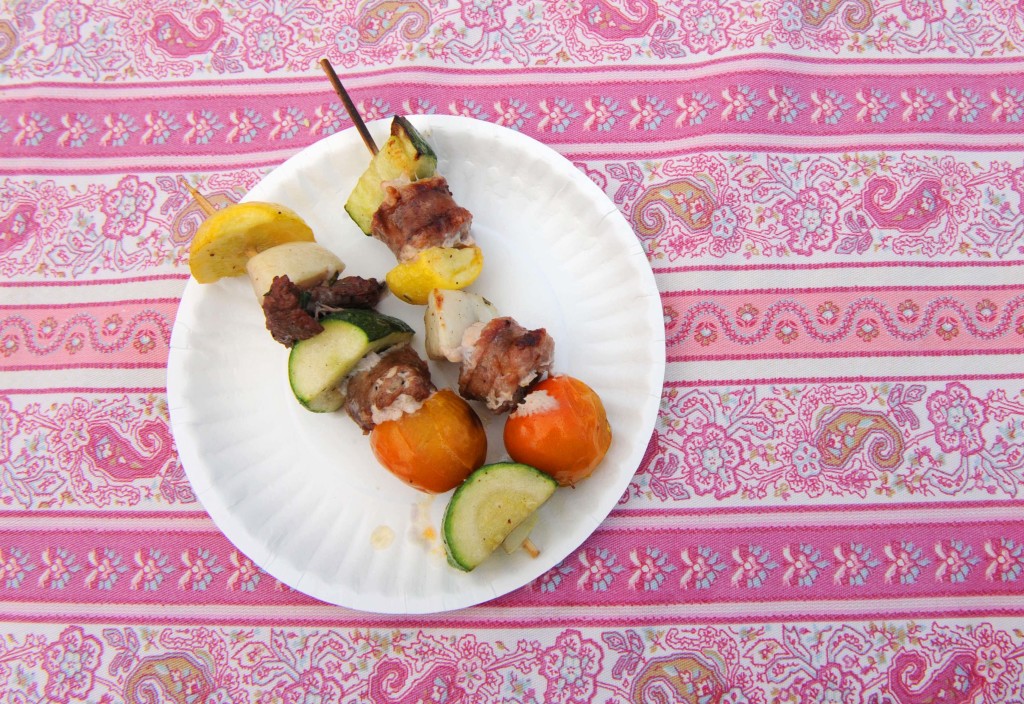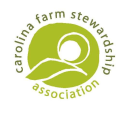I know, it’s been a while since I’ve written a post. This class was given way back in June and I ask your forgiveness for taking so long to put up the wonderful pictures that Casey Boone took for me and the recipes that were generated by the IBM Chef Watson application. Please enjoy them and use your creativity to make them your own.
Kabobs are a great way to let everybody customize their meal and have a little fun trying new foods from our local farms when you get together. They work for kids and adults and allow teens the opportunity to venture out on their own and help with the cooking too! Whether you choose, vegetarian, fish, meat or poultry combinations, understanding size, temperature and the role that marinades and spices can play is critical to pulling off a great grilled kabob. And that’s what we worked on during our class in June.
As the weather turns cool, I’m reminded of my summer class with The Home Fries just as school ended for many of them. The morning started with a slight breeze as we pulled out the charcoal grill at the Durham Farmers’ Market and readied it with hot coals.
While we waited for the coals to heat we shopped the market for a couple of items including parsley and onions. I’m reminded now of the beautiful celery, cabbage and carrots that were still coming in because farmers had planted late this year due to wet field conditions and a very late frost that killed many of the fruit blooms. There’s been some fall celery at the market lately that I love for fall soups. But in a pinch, those turnip stems you keep throwing out; save them in the freezer, chopped up and use them as a replacement when you run out of celery.
Then we played ‘follow the leader’ through the community herb and orchard right beside the farmers’ market. Seeds established and maintains this garden for everyone to enjoy and the entire community is welcome to use it. The ‘Garden of Eatin’ sits just behind the covered pavilion where the vendors park and sell each week. It’s easily accessible from the sidewalk or the pavilion with a walking path through the center. There are fruit bushes & dwarf trees and herbs lining both sides with a variety of traditional and unexpected plants, like a goumi berry bush. On our short walk we were able to cut fresh rosemary, thyme and oregano for our recipes but there’s also cilantro and parsley integrated in the garden.
When we got back to our tents, we talked about the recipes and came up with a production line for cutting all of our ingredients for Pork Sausage & White Turnip Kababs with Pesto and Beef Stew & Summer Veggie Kababs. Some of the kids cut up veggies, and some cut up herbs. I cheated and cut the meat ahead of time so we could keep it refrigerated safely.
The nice thing about both of the recipes, and many kabab combinations, is that you can cook the combinations in a foil package in the oven or in a cast iron pan as a stir fry if the weather is bad, or you don’t have access to a grill. Just remember to cook the meat, fish or poultry to a safe temperature inside the foil package or in the stir fry.
A simple meat thermometer is inexpensive, battery operated, and very small. In most cases, moisture from the vegetables will keep everything from burning inside a foil package. As a side tip, I like to add a layer of parchment paper inside the foil to help retain then moisture and keep everything from sticking to the aluminum foil.
We were fortunate to have been given the summer squash and zucchini by the folks at Eastern Carolina Organics for our class. ECO is made up of a group of farmers in our area that use organic methods to raise their produce. They sell in bulk to many of our local restaurants which helps local farms sell their bulk crops quickly when there’s more than they can sell at the market Their generosity left us enough budget money to pick up the meat for this class, which was a fun surprise for the kids. In fact, they gave us so many veggies that we were also able to send plenty home with each of the kids and a still have a little leftover to donate to Farmer Foodshare folks.
With sharp knives in hand, bamboo sticks waiting to be filled and hot coals on the grill, the kids showed me how fast they could whip up perfect size chunks of onion, zucchini, summer squash and tomatoes. Many of the kids were repeat students so they were well versed in how to use a knife and assisted the kids that needed some help.
We showed them how to spear everything with the wet bamboo sticks without stabbing themselves and put them on the grill. While they were cooking we talked about what flavors might work well together in different seasons. One idea was Goat and Cauliflower where the goat is soaked with cumin, garlic, yogurt and the cauliflower in olive oil with some curry spices and cubes of paneer. Or Lamb and Fig Kababs where the lamb is rubbed with allspice, cinnamon, and olive oil with a little garlic and the figs are fresh from the tree. Serving this with a little drizzle of balsamic olive oil to round out the flavors. Or substituting chicken or firm white fish in the beef recipe that we used with the summer vegetables but using a foil package to keep either from drying out or falling apart on the grill during the cooking process.
We checked on them occasionally and waited pretty patiently until they were ready!
And then we ate! My favorite part is seeing them all enjoy what they created and the wonderful face of success. It’s pretty easy to come up with a lot of different combinations by using applications like Pinterest or Instagram or visiting any number of food magazine websites that offer free content.
For this class I used IBM’s Chef Watson application because it allows me to choose local seasonal ingredients and then it sort of magically comes up with many ideas for recipes. At that point I try to narrow down some combinations that I think the kids will enjoy and that they can easily recreate at home.
The possibilities are really endless and you can change the ingredients even after you select a recipe to match what is available at the market that week. Saving the combinations in your personal recipe box allows you to come back to them or share using the FaceBook link. What I have enjoyed most about using this for class is the ability to challenge myself and students to think about unusual pairings of foods that grow in season together to eat more healthy local food.
Many thanks to the volunteers at the Durham Farmers’ Market that help pull this class off every summer no matter what the weather serves up! And also to my lovely photographer Casey Boone who knows how to move around me without me noticing her. All of the photos are hers, so please respect her copyrights and ask permission before you use them. And to Eastern Carolina Organics that supplied us with enough veggies to feed a small army. They supply many of our local restaurants with local organically grown farm food and I would not have been able to teach this class without their support.

